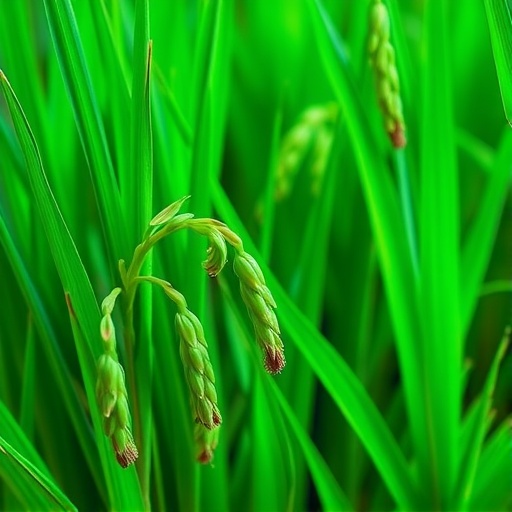
In recent years, the global agricultural community has been grappling with the escalating threats posed by fungal diseases to staple crops, particularly rice. Rice, as one of the most crucial food sources worldwide, sustains billions by providing a substantial portion of daily calorie intake. However, the productivity of this vital crop is severely compromised by diseases such as rice blast and brown spot, which collectively contribute to yield losses of up to 30 percent annually. Early and precise detection of these fungal infections is paramount to implementing timely agronomic interventions, thereby curbing losses and ensuring food security on a global scale.
Traditional diagnostic methods for plant diseases rely heavily on molecular techniques like PCR and ELISA, known for their accuracy but limited by logistical constraints in field settings. These methods require sample collection, extensive laboratory processing, and specialized equipment, making them impractical for rapid deployment in large agricultural landscapes. Such delays in disease identification often result in symptomatic manifestations becoming evident only after significant spread and damage have occurred, undermining disease management efforts.
Emerging as a groundbreaking alternative, chlorophyll fluorescence (ChlF) imaging offers a non-invasive, rapid, and sensitive approach to detect plant stress well before visual symptoms arise. Rooted in the photophysiology of plants, ChlF imaging measures the dynamic changes in light emission from chlorophyll molecules during photosynthesis. Pathogen-induced stress affects photosynthetic efficiency, altering fluorescence parameters in ways that can be captured and quantified using specialized imaging systems. This technique provides a window into the early pathogen-host interactions at the physiological level.
.adsslot_8fhuKrPXoE{width:728px !important;height:90px !important;}
@media(max-width:1199px){ .adsslot_8fhuKrPXoE{width:468px !important;height:60px !important;}
}
@media(max-width:767px){ .adsslot_8fhuKrPXoE{width:320px !important;height:50px !important;}
}
ADVERTISEMENT
A pioneering study conducted by a team led by Jae Hoon Lee at Seoul National University has harnessed advanced pulse-amplitude modulation (PAM) ChlF imaging to differentiate between rice blast and brown spot infections during their pre-symptomatic stages. Published in Plant Phenomics in early 2025, this research represents a monumental stride toward scalable, early disease diagnostics in rice. Employing a controlled detached leaf assay, the study meticulously examined fluorescence profiles from 120 leaves and over 750 infection spots across multiple time points, elucidating the subtle but distinctive fluorescence responses triggered by each fungal pathogen.
To rigorously model disease progression, researchers inoculated rice leaves with conidial suspensions of Magnaporthe oryzae and Cochliobolus miyabeanus, selecting pathogen concentrations optimized to induce isolated lesions reflective of natural disease scenarios. These inoculation parameters were crucial to maintaining a balance between disease severity and lesion distinctiveness, allowing a clear delineation of physiological changes attributable to each fungal species.
Analyzing ChlF data through sophisticated principal component analysis (PCA), the team discovered a marked divergence in fluorescence signatures not only between healthy and infected tissues but also between rice blast and brown spot infections at the pre-symptomatic phase. Among numerous fluorescence metrics assessed, photochemical quenching parameters emerged as significant indicators reflecting altered photosynthetic performance under pathogen stress. Intriguingly, rice blast infection exhibited distinctive reductions in non-photochemical quenching (NPQ) and qN parameters, contrasting with stability in these parameters during brown spot infection; this differential provides a biochemical fingerprint unique to each disease.
Harnessing machine learning algorithms, the study achieved remarkable classification accuracies exceeding 92% in distinguishing infected from healthy tissue, as well as effectively differentiating between the two disease types. Key ChlF parameters such as Rfd_L2 (fluorescence decline ratio), QY_Lss (steady-state quantum yield), and qP_Lss (photochemical quenching coefficient) constituted the core diagnostic features, validated through whole-plant assays that confirm the robustness of these markers under more complex, physiologically relevant environments.
This advancement unlocks unprecedented possibilities for integrating remote sensing tools with automated disease management systems for rice. By transitioning from labor-intensive and reactive disease identification toward proactive, precise monitoring, agricultural stakeholders can implement targeted fungicidal treatments, optimize resource allocation, and minimize environmental impact. Moreover, the scalability of ChlF imaging, facilitated by portable PAM-based devices, holds promise for large-scale field surveillance and smart farming applications.
The implications of this study extend beyond rice pathology, suggesting a paradigm shift in plant disease diagnostics across diverse crop systems. Early detection through chlorophyll fluorescence leverages fundamental changes in photosynthetic dynamics induced by biotic stresses, providing a universal principle applicable to myriad plant-pathogen interactions. Future research may explore integrating hyperspectral data and multi-modal sensing to enhance diagnostic resolution and operational utility.
Beyond technical prowess, the work embodies a significant stride towards safeguarding global food security. Rice blast and brown spot continue to pose persistent threats, with epidemic outbreaks often precipitated by delayed diagnosis and intervention. This innovative diagnostic methodology promises to curtail disease spread, reduce yield losses, and support sustainable agricultural development amid mounting challenges posed by climate change and population growth.
The Seoul National University team’s research was supported by the Rural Development Administration of Korea and the Creative-Pioneering Researchers Program, underscoring the importance of institutional support in advancing applied agricultural science. As efforts to translate this technology into field-ready solutions advance, collaborations among plant pathologists, engineers, and data scientists will be pivotal in fostering adoption and integration into existing crop management frameworks.
In conclusion, the deployment of PAM-based chlorophyll fluorescence imaging emerges as a transformative approach for early, non-invasive diagnostics of rice blast and brown spot diseases. This methodology not only enhances diagnostic accuracy but also enables timely, efficient interventions critical to minimizing crop losses. By illuminating the subtle physiological perturbations induced by pathogenic fungi before symptoms manifest, this technology equips farmers and researchers with a powerful tool in the collective endeavor to strengthen global food systems.
Subject of Research: Not applicable
Article Title: Pre-symptomatic diagnosis of rice blast and brown spot diseases using chlorophyll fluorescence imaging
News Publication Date: 12-Mar-2025
References: 10.1016/j.plaphe.2025.100012
Keywords: Agriculture, Technology, Biochemistry
Tags: agronomic interventions for crop protectionChlorophyll fluorescence imagingearly detection of fungal diseasesfood security and agricultural sustainabilityfungal disease impact on rice productivityinnovative agricultural technologymolecular techniques limitations in agriculturenon-invasive plant stress detectionphotophysiology in crop health monitoringrapid field diagnostics for plant diseasesrice blast and brown spot diseasesrice crop disease management





